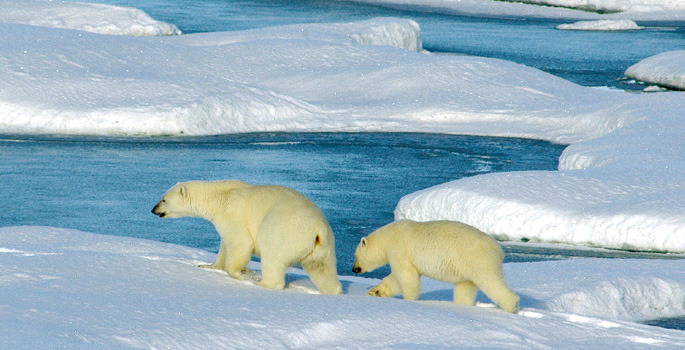Melting Arctic Circle Ice Drives Polar Bears Closer to Extinction
 The Arctic is the hot-seat of global warming, with rapidly melting ice a threat to polar bears, native arctic culture, and even the world’s coastal population living in warmer climates.
As temperatures rise from global warming, the Arctic’s average temperature increases are nearly twice that of the rest of the world. Over the past 50 years average temperatures in the Arctic have increased as much as 7 degrees Fahrenheit. In the next 100 years some areas in the Arctic may see an increase in average temperatures as high as 13 degrees Fahrenheit.
The Arctic is the hot-seat of global warming, with rapidly melting ice a threat to polar bears, native arctic culture, and even the world’s coastal population living in warmer climates.
As temperatures rise from global warming, the Arctic’s average temperature increases are nearly twice that of the rest of the world. Over the past 50 years average temperatures in the Arctic have increased as much as 7 degrees Fahrenheit. In the next 100 years some areas in the Arctic may see an increase in average temperatures as high as 13 degrees Fahrenheit.
As temperatures rise in the Arctic, sea ice and glaciers are melting at an unprecedented rate. Over the past 30 years, 386,000 square miles of Arctic sea ice have melted away, an area larger than Texas and Arizona combined. The latest observations suggest that Arctic sea ice could completely disappear during the summer as early as 2020.
Changes in the climate threaten life in the Arctic. The polar bear population is expected to decline by 30 percent in the next 35 to 50 years due to disappearing habitat induced by global warming. Warming induced changes in tundra vegetation and plant life threaten caribou, reindeer and migratory bird populations. Loss of sea ice and wildlife also makes indigenous life in the Arctic increasingly difficult, endangering an entire way of life.
Along with being home to polar bears and Arctic peoples, polar ice has also served as a mirror for the sun’s energy, reflecting much of it back out into space because of its light color. As more ice disappears, more dark ocean water and land will appear, soaking up heat instead of reflecting it, accelerating the warming of the Arctic and melting more ice.
On land, the majority of Arctic ice is frozen in the Greenland ice sheet. Between 1979 and 2002, the extent of melting in Greenland has increased on average by 16 percent – an area roughly the size of Sweden. In the record-breaking year of 2005, parts of Greenland melted that have never melted during the 26-year long satellite record. A complete melting of Greenland would result in over a 20 foot rise in global sea level, presenting catastrophic consequences to coastal regions around the world. Furthermore, melting Arctic glaciers would contribute large amounts of fresh water into the ocean, changing oceanic currents, damaging eco-systems and creating unprecedented weather conditions.
More facts on the Arctic:
-Melting permafrost—ice that has permanently frozen in the ground—in the Artic Circle is increasing the amount of heat-trapping gases like methane released into the atmosphere. Permafrost traps these gases while frozen, but global warming is causing more melting, which causes the release of these gases.
-According to computer modeling of future climate impacts, even moderate estimates predict that in the next 100 years average arctic temperatures will rise 5-9 degrees Fahrenheit on land and 13 degrees Fahrenheit over the water.
-NASA satellites show that permanent ice cover in the Arctic is diminishing by 9 percent each decade.
 The Arctic is the hot-seat of global warming, with rapidly melting ice a threat to polar bears, native arctic culture, and even the world’s coastal population living in warmer climates.
As temperatures rise from global warming, the Arctic’s average temperature increases are nearly twice that of the rest of the world. Over the past 50 years average temperatures in the Arctic have increased as much as 7 degrees Fahrenheit. In the next 100 years some areas in the Arctic may see an increase in average temperatures as high as 13 degrees Fahrenheit.
The Arctic is the hot-seat of global warming, with rapidly melting ice a threat to polar bears, native arctic culture, and even the world’s coastal population living in warmer climates.
As temperatures rise from global warming, the Arctic’s average temperature increases are nearly twice that of the rest of the world. Over the past 50 years average temperatures in the Arctic have increased as much as 7 degrees Fahrenheit. In the next 100 years some areas in the Arctic may see an increase in average temperatures as high as 13 degrees Fahrenheit.